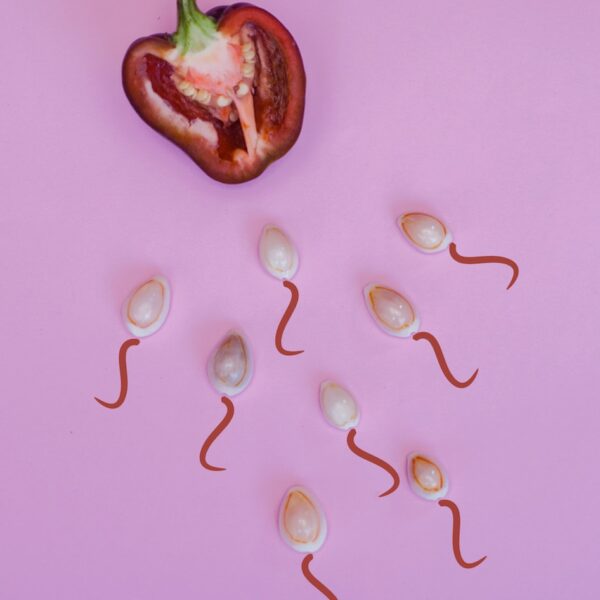In men, sperm production takes place in the testicles. The process is known as spermatogenesis and it takes around 2.5 months to go from start to finish.
In vessels within the testicles called the seminiferous tubules, germ cells (diploid cells with 46 chromosomes) divide to create multiple haploid spermatids. These spermatids then develop the head and tail we recognize as sperm, or spermatozoa.
Sperm Cells
Sperm are tadpole-shaped male sex cells that carry the genetic information needed to create a new human being. They are haploid cells, which means they only contain 23 chromosomes (half the number of chromosomes found in a normal cell). Once sperm fertilize an egg, the resulting fertilized eggs become fetuses.
The sperm-making process, known as spermatogenesis, takes about 70 days to complete from start to finish. This is because it can take quite a while for immature germ cells to reach maturation in the seminiferous tubules of the testes.
Once the sperm cells have matured, they can be released into the seminal fluid through the ejaculatory canal. They will then be able to swim through the female reproductive tract until they meet an egg, which is where fertilization occurs. During the journey to the egg, sperm can survive for up to 5 days. This is because the female body has the right conditions of humidity and temperature for them to survive.
During this time, the sperm cells are propelled by a structure called the flagellum. The flagellum is powered by mitochondria. These mitochondria are tightly packed into the sperm cells to provide them with the energy they need to move around. It is also thought that the presence of the mitochondria is what causes sperm to have such high levels of antioxidant enzymes.
Spermatogenesis
Sperm cells are made in a process called spermatogenesis, which is triggered by the pituitary gland’s production of hormones such as follicle-stimulating hormone (FSH) and luteinizing hormone (LH). It generally begins at puberty and takes place inside the testicles in rounded structures called seminiferous tubules.
These tubes are lined with specialized epithelial cells called Sertoli cells, which provide nourishment to developing sperm cells known as spermatocytes. After a period of cell division, spermatocytes give rise to sperm precursor cells called type A and type B spermatogonia. A type B spermatocyte can then produce four mature sperm cells once the spermatogonial stem cells enter the meiotic phase of cell division.
During meiosis, the spermatogonia separate their 46 chromosomes into two identical sets of 23 chromosomes each. Each resulting sperm cell is now a haploid gamete, which contains 23 chromosomes in its nucleus and the same number in its cytoplasm. The gametes are then released from the spermatogenic follicle and pass through the epididymis, where they undergo further maturation and develop a tail known as the flagellum.
During this final stage of sperm development, the acrosomal granule of each spermatocyte becomes closely applied to its elongating nucleus. The centrioles of the sperm cell also grow microtubules that eventually form the axoneme of the sperm’s flagellum. The axoneme gives the sperm its ability to travel through the female reproductive tract to reach an egg and fertilize it.
Ejaculation
When you’re sexually aroused, sperm travel through the vas deferens, which takes them toward a cavity in the pelvis called the urethra. Along the way, sperm move through a layer of cervical mucus and seminal fluid.
Unlike most other cells in the body, sperm are alive and can only survive by moving. In fact, the ability to move is what makes sperm “sperm” and what enables them to reach an egg to fertilize it. That movement is known as motility, and the sperm that don’t make it are broken down and reabsorbed by the body.
Fertilization occurs when a sperm joins with an egg cell to create a new organism, starting with the fertilized eggs 23 chromosomes and combining them with the sperm’s 46 chromosomes. After fertilization, a fertilized egg becomes a diploid zygote.
Once a man has produced sperm, the mature ones are stored in the epididymis (a long, tube-like structure located in the scrotum). During sexual stimulation, the mature sperm are released from the epididymis and enter a fluid in the urethra called semen. Semen contains fluids secreted by a number of glands in the testicles and penis, including the vas deferens, seminal vesicles and prostate gland. About 80% of the semen volume comes from the vas deferens and the remainder comes from the prostate gland and seminal vesicles. Only about 10% of the semen contains actual sperm cells.
Fertilization
Men produce millions of sperm every day, though the quality and count decrease as they age. Nevertheless, healthy sperm are still essential to conception because it only takes one to fertilize an egg.
After sex, sperm swim to the female reproductive tract where they’re met by cervical mucus that helps nurture them and facilitates swimming through the vaginal wall and cervix. This is a crucial step because the environment in this area of the body is acidic, and the sperm must be able to overcome it without being destroyed. The sperm also must be capable of penetrating the egg cell, a process called capacitation.
The sperm are immature when they enter the vagina, but they’re able to swim due to their tails that contain a protein called semen. This substance contains vitamins, minerals, and enzymes, as well as sperm cells.
Once inside the uterus, the sperm must survive for up to five days while swimming to the egg. The journey is made difficult by a thick layer of mucus that protects the egg, as well as the fact that sperm can only swim in a limited pool of lubricating fluid, which is produced in the vagina. In order to make it across this barrier, the sperm must convert their heads to a tadpole-like shape that will allow them to penetrate the membrane of the egg and fuse with its pronucleus.




Leave a Comment